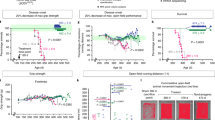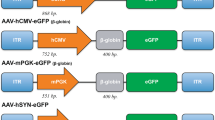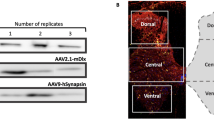Abstract
Retrograde transport of viral vectors in the rodent spinal cord provides a powerful means to administer a therapeutic transgene from the innervated musculature. With the aim of scaling up this approach to non-human primates, we have injected recombinant adeno-associated vectors (rAAV) serotype 6 expressing enhanced green fluorescent protein (eGFP) into the gastrocnemius muscle of African green monkeys to determine whether this results in efficient transgene delivery to lumbar motor neurons. Cells expressing eGFP were observed across more than 1 cm of the spinal cord 4 weeks after intramuscular injection, reaching more than half of motor neurons in some cross-sections. Furthermore, quantitative PCR on the spinal cord tissue confirmed that eGFP expression within motor neurons was due to bona fide retrograde transport of the vector genome from the muscle. Although infiltrations of macrophages and lymphocytes were observed in the rAAV2/6-injected muscle, there was no detectable immune response within the transduced region of the spinal cord. These findings imply that retrograde delivery of rAAV serotype 6 in a primate species constitutes a non-invasive and robust approach to transduce motor neurons, a crucial target cell population in neurodegenerative disorders, such as amyotrophic lateral sclerosis and spinal muscular atrophy.
This is a preview of subscription content, access via your institution
Access options
Subscribe to this journal
Receive 12 print issues and online access
$259.00 per year
only $21.58 per issue
Buy this article
- Purchase on Springer Link
- Instant access to full article PDF
Prices may be subject to local taxes which are calculated during checkout




Similar content being viewed by others
References
Azzouz M, Le T, Ralph GS, Walmsley L, Monani UR, Lee DC et al. Lentivector-mediated SMN replacement in a mouse model of spinal muscular atrophy. J Clin Invest 2004; 114: 1726–1731.
Ralph GS, Radcliffe PA, Day DM, Carthy JM, Leroux MA, Lee DC et al. Silencing mutant SOD1 using RNAi protects against neurodegeneration and extends survival in an ALS model. Nat Med 2005; 11: 429–433.
Yamashita S, Mita S, Kato S, Okado H, Ohama E, Uchino M . Effect on motor neuron survival in mutant SOD1 (G93A) transgenic mice by Bcl-2 expression using retrograde axonal transport of adenoviral vectors. Neurosci Lett 2002; 328: 289–293.
Kaspar BK, Lladó J, Sherkat N, Rothstein JD, Gage FH . Retrograde viral delivery of IGF-1 prolongs survival in a mouse ALS model. Science 2003; 301: 839–842.
Miller TM, Kaspar BK, Kops GJ, Yamanaka K, Christian LJ, Gage FH et al. Virus-delivered small RNA silencing sustains strength in amyotrophic lateral sclerosis. Ann Neurol 2005; 57: 773–776.
Mandel RJ, Manfredsson FP, Foust KD, Rising A, Reimsnider S, Nash K et al. Recombinant adeno-associated viral vectors as therapeutic agents to treat neurological disorders. Mol Ther 2006; 13: 463–483.
Daya S, Berns KI . Gene therapy using adeno-associated virus vectors. Clin Microbiol Rev 2008; 21: 583–593.
Towne C, Raoul C, Schneider BL, Aebischer P . Systemic AAV6 delivery mediating RNA interference against SOD1: neuromuscular transduction does not alter disease progression in fALS mice. Mol Ther 2008; 16: 1018–1025.
Wu Z, Asokan A, Grieger JC, Govindasamy L, Agbandje-McKenna M, Samulski RJ . Single amino acid changes can influence titer, heparin binding, and tissue tropism in different adeno-associated virus serotypes. J Virol 2006; 80: 11393–11397.
Toromanoff A, Chérel Y, Guilbaud M, Penaud-Budloo M, Snyder RO, Haskins ME et al. Safety and efficacy of regional intravenous (r.i.) versus intramuscular (i.m.) delivery of rAAV1 and rAAV8 to nonhuman primate skeletal muscle. Mol Ther 2008; 16: 1291–1299.
Pirozzi M, Quattrini A, Andolfi G, Dina G, Malaguti MC, Auricchio A et al. Intramuscular viral delivery of paraplegin rescues peripheral axonopathy in a model of hereditary spastic paraplegia. J Clin Invest 2006; 116: 202–208.
Hollis II ER, Kadoya K, Hirsch M, Samulski RJ, Tuszynski MH . Efficient retrograde neuronal transduction utilizing self-complementary AAV1. Mol Ther 2008; 16: 296–301.
Klein RL, Dayton RD, Tatom JB, Henderson KM, Henning PP . AAV8, 9, Rh10, Rh43 vector gene transfer in the rat brain: effects of serotype, promoter and purification method. Mol Ther 2008; 16: 89–96.
Wang Z, Kuhr CS, Allen JM, Blankinship M, Gregorevic P, Chamberlain JS et al. Sustained AAV-mediated dystrophin expression in a canine model of Duchenne muscular dystrophy with a brief course of immunosuppression. Mol Ther 2007; 15: 1160–1166.
Yuasa K, Yoshimura M, Urasawa N, Ohshima S, Howell JM, Nakamura A et al. Injection of a recombinant AAV serotype 2 into canine skeletal muscles evokes strong immune responses against transgene products. Gene Therapy 2007; 14: 1249–1260.
Ohshima S, Shin JH, Yuasa K, Nishiyama A, Kira J, Okada T et al. Transduction efficiency and immune response associated with the administration of AAV8 vector into dog skeletal muscle. Mol Ther 2009; 17: 73–80.
Chirmule N, Xiao W, Truneh A, Schnell MA, Hughes JV, Zoltick P et al. Humoral immunity to adeno-associated virus type 2 vectors following administration to murine and nonhuman primate muscle. J Virol 2000; 74: 2420–2425.
Peden CS, Burger C, Muzyczka N, Mandel RJ . Circulating anti-wild-type adeno-associated virus type 2 (AAV2) antibodies inhibit recombinant AAV2 (rAAV2)-mediated, but not rAAV5-mediated, gene transfer in the brain. J Virol 2004; 78: 6344–6359.
Reimsnider S, Manfredsson FP, Muzyczka N, Mandel RJ . Time course of transgene expression after intrastriatal pseudotyped rAAV2/1, rAAV2/2, rAAV2/5, and rAAV2/8 transduction in the rat. Mol Ther 2007; 15: 1504–1511.
Hadaczek P, Forsayeth J, Mirek H, Munson K, Bringas J, Pivirotto P et al. Transduction of nonhuman primate brain with adeno-associated virus serotype 1: vector trafficking and immune response. Hum Gene Ther 2009; 20: 225–237.
Lowenstein PR, Mandel RJ, Xiong WD, Kroeger K, Castro MG . Immune responses to adenovirus and adeno-associated vectors used for gene therapy of brain diseases: the role of immunological synapses in understanding the cell biology of neuroimmune interactions. Curr Gene Ther 2007; 7: 347–360.
Manno CS, Pierce GF, Arruda VR, Glader B, Ragni M, Rasko JJ et al. Successful transduction of liver in hemophilia by AAV-Factor IX and limitations imposed by the host immune response. Nat Med 2006; 12: 342–347.
Pearn J . Incidence, prevalence, and gene frequency studies of chronic childhood spinal muscular atrophy. J Med Genet 1978; 15: 409–413.
Grimm D, Kay MA, Kleinschmidt JA . Helper virus-free, optically controllable, and two-plasmid-based production of adeno-associated virus vectors of serotypes 1 to 6. Mol Ther 2003; 7: 839–850.
Acknowledgements
We thank K Löw, V Setola, F Santoni de Sio, JC Bensadoun, F Pidoux, C Sadeghi, V Padrun and the staff at St. Kitts Biomedical for their technical assistance, especially E Nisbett. This work was supported by the Bruno and Ilse Frick Foundation and by the Axion Research Foundation.
Author information
Authors and Affiliations
Corresponding author
Additional information
Supplementary Information accompanies the paper on Gene Therapy website (http://www.nature.com/gt)
Supplementary information
Rights and permissions
About this article
Cite this article
Towne, C., Schneider, B., Kieran, D. et al. Efficient transduction of non-human primate motor neurons after intramuscular delivery of recombinant AAV serotype 6. Gene Ther 17, 141–146 (2010). https://doi.org/10.1038/gt.2009.119
Received:
Revised:
Accepted:
Published:
Issue Date:
DOI: https://doi.org/10.1038/gt.2009.119
Keywords
This article is cited by
-
Drug delivery to the central nervous system
Nature Reviews Materials (2021)
-
Gene delivery to the hypoglossal motor system: preclinical studies and translational potential
Gene Therapy (2021)
-
AAV9-Retro mediates efficient transduction with axon terminal absorption and blood–brain barrier transportation
Molecular Brain (2020)
-
Molecular Approaches for the Treatment of Pompe Disease
Molecular Neurobiology (2020)
-
Nigrostriatal and mesolimbic control of sleep–wake behavior in rat
Brain Structure and Function (2019)



